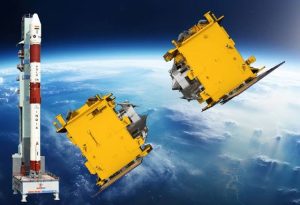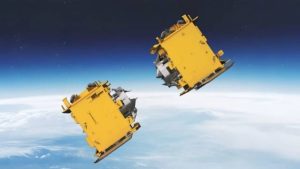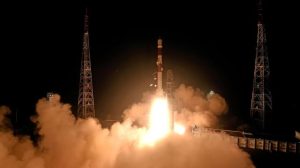Digital News Guru Technology Desk:
On January 16, 2025, the Indian Space Research Organisation (ISRO) achieved a significant milestone by successfully conducting its first space docking mission, known as the Space Docking Experiment (SpaDeX). This accomplishment positions India as the fourth nation globally to master space docking technology, following the United States, Russia, and China.
SpaDeX: Mission Overview
The SpaDeX mission was designed to test autonomous docking capabilities in space, a critical technology for future missions such as space station construction, satellite servicing, and interplanetary exploration. The experiment involved two satellites developed by ISRO, referred to as the “Chaser” and the “Target.”

Each satellite weighed approximately 220 kilograms and was equipped with advanced sensors, propulsion systems, and docking mechanisms to perform the complex maneuvers necessary for a successful docking.
The satellites were launched on December 30, 2024, aboard the PSLV-C60 (Polar Satellite Launch Vehicle) from the Satish Dhawan Space Centre in Sriharikota. Placed in a 475-kilometer circular orbit with a 55-degree inclination, the Chaser and Target satellites began a series of controlled maneuvers to align their orbits and approach one another. The mission’s primary goal was to execute docking autonomously, with minimal intervention from ground control.
The Docking Process
Space docking involves two spacecraft coming together in orbit to create a physical and functional connection. For SpaDeX, this entailed a sequence of precision steps:
- Rendezvous: The Chaser satellite gradually approached the Target satellite using thrusters and sensors to reduce the distance between them while maintaining precise alignment.
- Proximity Operations: At a safe distance, the Chaser performed delicate adjustments to match the Target’s speed and orientation.
- Final Approach and Docking: The two satellites engaged docking mechanisms, completing the process with an energy-efficient and safe connection.
The mission also demonstrated critical secondary objectives, including the transfer of electric power between the docked satellites and validation of in-orbit composite spacecraft control systems.

Challenges and Delays
The SpaDeX mission faced its share of hurdles. Initially slated for an early January docking attempt, the mission encountered unexpected excess drift between the satellites during pre-docking maneuvers. This led to a review and recalibration of ground simulations, resulting in two postponements before the final successful attempt. These challenges underscored the complexity of space docking and the precision required to execute it flawlessly.
Despite the delays, the eventual success highlighted ISRO’s commitment to excellence and thoroughness, ensuring that every aspect of the mission was meticulously validated before execution.
Significance of the Achievement
Mastering space docking technology has far-reaching implications for India’s space program and its future ambitions. Here’s why SpaDeX is a game-changer:
- Space Station Development: The ability to dock spacecraft is essential for assembling and maintaining space stations. ISRO’s long-term plans to establish its own space station now seem more achievable.
- Satellite Servicing: SpaDeX paves the way for in-orbit repair and refueling of satellites, potentially extending their operational lifespans and reducing space debris.
- Crewed Missions: Autonomous docking is a critical capability for future crewed lunar and Mars missions, where spacecraft need to dock with orbiters or space habitats.
- Global Collaboration: By proving its expertise in this domain, India strengthens its position as a reliable partner in international space missions.
What’s Next for ISRO?
The success of SpaDeX has set the stage for even more ambitious projects. ISRO has plans to further enhance its docking capabilities, potentially incorporating robotic arms and advanced modular spacecraft designs. Additionally, the mission aligns with India’s aspirations to participate more actively in global space exploration efforts and expand its share in the rapidly growing commercial space market.

Conclusion
India’s successful space docking test is a testament to ISRO’s technological ingenuity and its ability to overcome challenges in pursuit of excellence. This historic milestone not only propels India’s space program into a new era but also inspires confidence in its capacity to undertake complex and ambitious missions. As the nation sets its sights on constructing space stations, servicing satellites, and embarking on interplanetary explorations, the success of SpaDeX serves as a strong foundation for future achievements.
You May Also Read: Beauty Secrets of Love Island’s India Reynolds: A Deep Dive into Her Skincare and Makeup Routine








